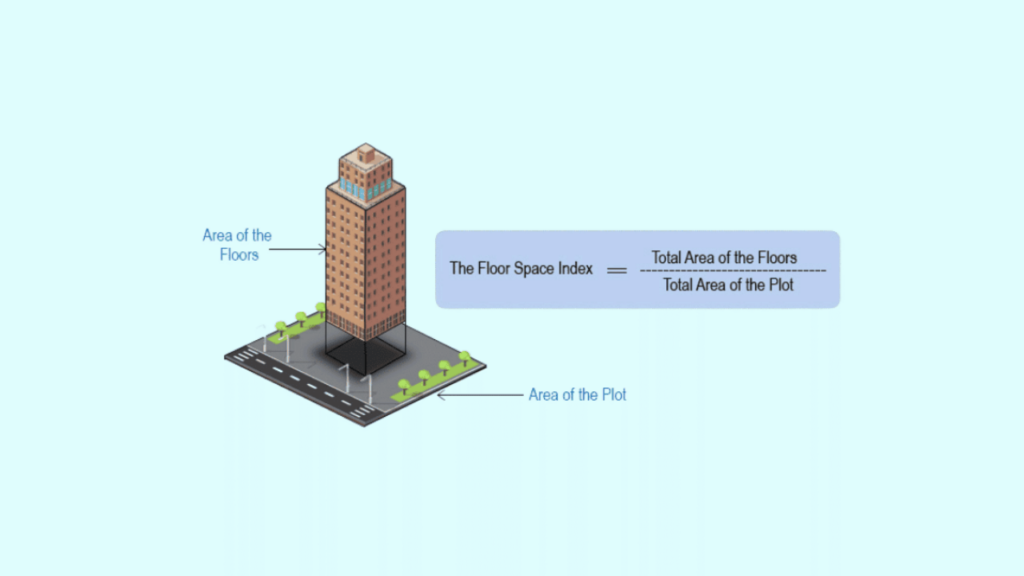What Is Floor Space Index? Easy Explanation for Homebuyers
When selecting a property to live in, it is crucial to have a clear understanding of Floor Space Index (FSI), its meaning and how it is calculated. This knowledge will help you assess whether the house size aligns with your requirements for an ideal home.
FSI represents the ratio of the total area covered by all the floors of a building to the total land area on which the buildings are constructed. The built up area refers to the cumulative area covered by all levels within a building. Let’s delve deeper into this concept to enhance our understanding.
Introduction to Floor Space Index (FSI)

Floor Space Index (FSI) is the total area a builder can use to build infrastructure on a particular piece of land. It can be understood as the ratio of the building floor covered to the area available on the land. FSI of a specific plot depends on the rules and regulations set by the city’s municipal authorities or the state’s administrative government, hence they vary from location to location.
Furthermore, FSI of the same zonal areas will vary based on road width, plot size etc. There are non FSI areas defined by local authorities of specific zones. In some states, staircases, service rooms, parking areas and open balconies are part of FSI. We must refer to the local building norms to understand the exclusions for FSI calculation.
Floor Space Index (FSI) also known as Floor Area Ratio (FAR) in some regions, serves as a crucial metric in urban planning and real estate development. This ratio dictates the maximum permissible construction allowed on a specific plot, regulating the density and scale of buildings within a given area.
The implications of FSI extend beyond mere numerical calculations as they profoundly influence the urban fabric, determining factors such as building height, setback requirements and overall density. Higher FSI values often lead to denser developments, with taller buildings and a greater concentration of built up space within a given area. Conversely, lower FSI values result in more spacious layouts, characterized by lower building heights and larger setbacks.
Understanding the Importance of FSI in Construction

Floor Space Index (FSI) serves as a fundamental parameter in construction, exerting a major influence on the design, scale and feasibility of building projects. Recognizing the significance of FSI is pivotal for architects, developers and urban planners alike, as it directly shapes the built environment and determines the utilization of land resources. Here’s a closer look at why FSI holds such paramount importance in construction:
- Urban Density Management: FSI plays a pivotal role in regulating urban density by stipulating the maximum allowable built up area on a given plot of land. In densely populated urban areas, FSI restrictions help maintain a balance between the demand for space and the need to preserve open areas, green spaces and adequate infrastructure.
- Efficient Land Utilization: By defining the permissible ratio of built up area to the total land area, FSI promotes efficient land utilization. Optimal utilization of land resources is crucial for sustainable urban development, ensuring that available space is utilized effectively without excessive sprawl or wastage.
- Regulatory Compliance: Compliance with FSI regulations is a legal requirement for construction projects in most jurisdictions. Failure to adhere to prescribed FSI limits can result in regulatory penalties, delays or even project cancellation. Therefore understanding and adhering to FSI guidelines is essential for ensuring project viability and avoiding legal complications.
- Economic Viability: FSI directly impacts the economic feasibility of construction projects. Higher FSI values enable developers to maximize the utilization of available land, thereby increasing the potential return on investment. Conversely, lower FSI values may pose challenges in achieving desirable project economics, especially in high cost urban areas.
Floor Space Index Calculation

Having grasped the concept of FSI, the next logical step would be to understand how to calculate FSI for a property. Floor space index is commonly represented as a percentage, but the floor area is typically expressed as a ratio. In terms of the floor space index, a floor area ratio of 1.4 would be stated as 140 percent.
The formula for FSI calculation:

For instance, if the maximum allowed FSI in a zone is 1.5 and the builder has a 1,000 square-meter plot for construction, the builder will follow the DCR (Developmental Control Rules). The builder is then allowed to construct up to 1,500 square meters on this property. Depending on the style of construction and the number of levels allowed, this 1,500 sq. m covered area could be divided into two 750 square meters floors or three 500 square meters floors. The finished area would include the basic framework, walls, stairwells and, if applicable, lobby space. This number is subject to fluctuation depending on the allowed FSI.
Legal Regulations and Guidelines Regarding FSI

Floor Space Index (FSI) is subject to numerous legal regulations and guidelines that vary based on regional zoning laws, urban planning policies and building codes. These regulations are put in place to ensure orderly urban development, efficient land use and adherence to safety and environmental standards. Here are some common legal regulations and guidelines concerning FSI:
- Zoning Ordinances: Municipalities often establish zoning ordinances that govern land use, density, and building height within different zones or districts. FSI regulations are typically incorporated into these ordinances, specifying the maximum allowable FSI for each zone. Zoning maps delineate areas with different FSI restrictions, such as residential, commercial, industrial or mixed use zones.
- Development Plans: Many jurisdictions have comprehensive development plans or master plans that outline long-term visions for urban growth and development. These plans often include FSI targets and guidelines aimed at achieving specific planning objectives, such as promoting transit oriented development, preserving historic districts or enhancing public spaces.
- Public Review and Approval Processes: Major development projects subject to FSI regulations often undergo public review and approval processes, which may involve public hearings, environmental assessments, and input from various stakeholders. Municipal planning departments, zoning boards, or other regulatory bodies typically oversee these processes to ensure compliance with FSI regulations and other applicable requirements.
Understanding these regulations is crucial for developers, architects, planners and policymakers to navigate the complexities of FSI and ensure compliance with applicable laws and standards. It’s always best to consult a professional who knows the ins and outs of property laws. Consult our professionals at Enquire at ASBL.
Utilizing FSI for Efficient Space Planning
FSI (Floor Space Index) serves as a crucial tool for efficient space planning in urban development. Here’s how:
- Zoning Regulations: FSI is integrated into zoning ordinances, specifying the maximum allowed floor area relative to lot size and building height for different zones.
- Variances and Permits: Variances or special permits may be sought for projects that deviate from standard FSI regulations, subject to public review and approval processes.
- Development Plans: FSI targets in development plans guide long term urban growth strategies, promoting sustainable development and balanced land use.
FSI and its Impact on Property Prices

- Development Potential: Higher FSI allows for increased construction density, enabling developers to build more floors or units on a given plot of land. Properties with higher FSI tend to have greater development potential, commanding higher prices due to the possibility of maximizing floor area and generating higher returns on investment.
- Location Value: FSI regulations vary across different locations and zoning districts. Properties in areas with higher FSI allowances, typically urban centers or transit oriented developments, tend to command premium prices due to the increased development opportunities and accessibility.
- Amenities and Quality of Life: FSI regulations influence the design and layout of developments, impacting the availability of amenities, open spaces and overall quality of life. Properties in developments with optimal FSI utilization, offering desirable amenities and urban conveniences, often command higher prices due to increased attractiveness to homebuyers.
- Investment Potential: FSI regulations can signal growth potential and investment opportunities in emerging or redevelopment areas. Properties located in areas with anticipated increases in FSI allowances or redevelopment plans may experience appreciation in value as investors speculate on future development prospects.
FSI regulations have a multifaceted impact on property prices, shaping market dynamics, investment decisions and urban development patterns. Understanding the interplay between FSI and property prices is essential for stakeholders in the real estate industry to assess market trends, evaluate investment opportunities and make informed decisions.
Conclusion
As we wrap up our journey through FSI, it’s like finding our way through a big city with a map. FSI is like a rulebook for building stuff in cities. It tells us how much we can build on a piece of land. We’ve also seen how FSI rules are made by city governments and how they impact things like how tall buildings can be, how many apartments can fit in a block, and even how nice a neighborhood is. Whether you’re looking to buy a home or build something new, knowing about FSI helps you make smart choices. It’s like having a secret map to navigate the city’s rules and make sure your plans fit in just right. For more enquiries, visit Enquire at ASBL.
FAQs
FSI is calculated by dividing the total built-up area of a building by the total area of the plot land it’s built on. The result is the ratio of floor area to land area.
FSI regulations are determined by local zoning laws, urban planning policies, building codes and environmental considerations. These regulations vary from one area to another and dictate the maximum allowable development on a given plot of land.
In some cases, variances or special permits may allow developers to exceed standard FSI regulations. However, obtaining such approvals usually involves a thorough review process and adherence to specific criteria.
Homebuyers can use FSI information to assess the development potential of potential of properties, understand neighborhood density, and anticipate future changes in the built environment.
A higher FSI value may strain infrastructure, create congestion and impact quality of life.













